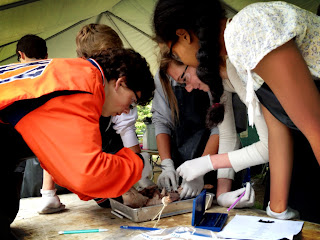 Like many teachers right now, I am busy reflecting, preparing, and brainstorming while trying to ignore the last few days of summer. My flip flops seem to be yearning for one more trip to the beach, and my alarm clock is ready and waiting to be used! As I try focus on what can be a busy time of year, I have decided to recap my "Favorite Things" from last year with my students (feel free to insert a little Julie Andrews singing if it helps). Some are major projects where light bulbs went off, others are quieter, more subtle ideas that just made life better. I hope you enjoy a glimpse into my world with some amazing students who keep me smiling, loving what I do, and looking forward to seeing them continue to grow.
Like many teachers right now, I am busy reflecting, preparing, and brainstorming while trying to ignore the last few days of summer. My flip flops seem to be yearning for one more trip to the beach, and my alarm clock is ready and waiting to be used! As I try focus on what can be a busy time of year, I have decided to recap my "Favorite Things" from last year with my students (feel free to insert a little Julie Andrews singing if it helps). Some are major projects where light bulbs went off, others are quieter, more subtle ideas that just made life better. I hope you enjoy a glimpse into my world with some amazing students who keep me smiling, loving what I do, and looking forward to seeing them continue to grow.
1. Book Creator Fetal Pig Lab Projects- Nothing is better than having my students asking to come to class during study halls or free time to get better pictures and ask deeper questions about the anatomy and physiology that so closely resembles their own. @BookCreator has changed how I teach in more ways than I can explain. The fact that my students know they are publishing their work adds another level of focus that cannot be otherwise provided.
 2. Crime Lab "Mockumentary" Project- This a super way to incorporate many lab skills, content objectives, cooperative learning, and team building moments into one activity. This is a 3 week project where all of my students are split into teams to solve a murder mystery. The kicker is that the entire middle school faculty is suspect of the crime! Check out my blog post about this project. I guarantee your students will love it!
2. Crime Lab "Mockumentary" Project- This a super way to incorporate many lab skills, content objectives, cooperative learning, and team building moments into one activity. This is a 3 week project where all of my students are split into teams to solve a murder mystery. The kicker is that the entire middle school faculty is suspect of the crime! Check out my blog post about this project. I guarantee your students will love it!
3. Free "Charge" Bar- It is amazing how making the 15 open slots in my iPad cart available to students can be such a game changer! First, it gets the phones out of their hands/pockets and their eyes looking up. Second, the times that they drop their phones off and pick them up give me two extra personal touches during the day. Third, word got out, so I am lucky to have kids whom I don't teach come by and drop off their phones for some "free phone daycare".
4. Mystery Skype- This is a total game changer! I am looking forward to next year's Global Collaboration Day already! Thank you, Jodie Deinhammer @jdeinhammer
5. Cel.ly- I am fortunate to teach in a community where most students have smart phones. We have been able to send out student activity text messages to remind them of events, fund raisers, schedule changes and more. I also have one for my classroom to send out assignment reminders, sample questions, and reminders.
So whether you are still planning or you are fully immersed in a new school year, I wish you luck and the confidence to try something new!
To learn more ways in which I am using technology in my classroom, follow me on Twitter @eglassman757.
So whether you are still planning or you are fully immersed in a new school year, I wish you luck and the confidence to try something new!
To learn more ways in which I am using technology in my classroom, follow me on Twitter @eglassman757.




















.JPG)


.JPG)










.JPG)


.JPG)
.JPG)












